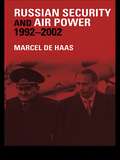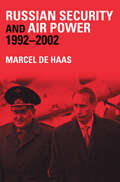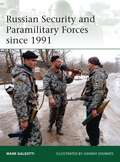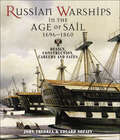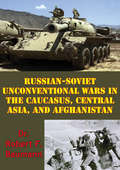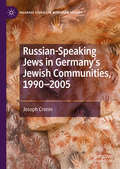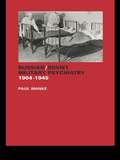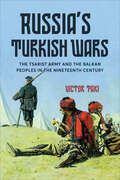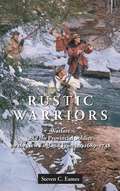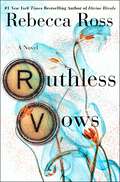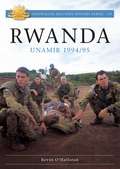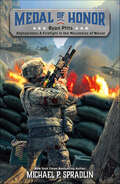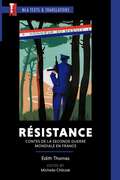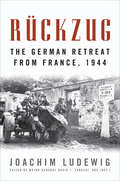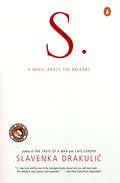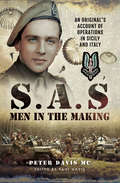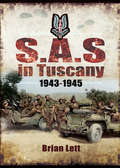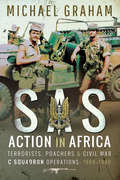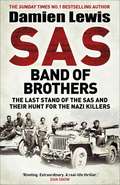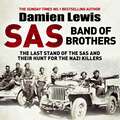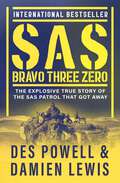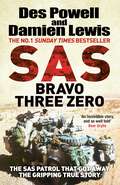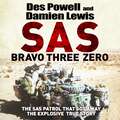- Table View
- List View
Russian Security and Air Power, 1992-2002 (Soviet (Russian) Military Theory and Practice)
by Marcel De HaasThis new book analyzes the security policy of the Russian Federation, internally as well as externally, on all levels of strategy. It describes military and political decision-making from Moscow's grand strategy to the use of a single fighter aircraft in Chechnya. In this analysis, Russia's air forces are used as a model for all services of the armed forces.The Chechen conflicts and NATO's security policy have been dominant factors in the development of Russia's security policy during the period 1992-2002. The use of air power in the Chechen conflicts is used here as a case study for testing political and military-strategic objectives. With regard to NATO's security policy, this study shows that the eastward enlargement of this alliance, as well as its use of force in Bosnia and Kosovo, have caused an increase in anti-Western tendencies in Russian security thinking.
Russian Security and Air Power, 1992-2002 (Soviet (Russian) Military Theory and Practice)
by Marcel de HaasFirst published in 2006. Routledge is an imprint of Taylor & Francis, an informa company.
Russian Security and Paramilitary Forces since 1991
by Johnny Shumate Mark GaleottiWhilst under Putin's regime the size of Russia's regular forces has shrunk recently and will continue to do so, its security and paramilitary elements have become increasingly powerful. In fact, recently they have proliferated - as have their special uniforms and kit - and have become disproportionately important, spearheading all recent operations. They seem set to remain Russia's most active armed agencies for the immediate future. In parallel, within the murky world where government and private interests intersect, a number of paramilitary 'private armies' operate almost as vigilantes, with government toleration or approval.This book offers a succinct overview of the official, semi-official and unofficial agencies that pursue Russian government and quasi-government objectives by armed means, from the 200,000-strong Interior Troops, through Police and other independent departmental forces, down to private security firms (in Moscow alone, the largest four security companies have c. 8,000 armed operatives). While some elements have been created in response to real challenges from terrorism and organized crime, other special groups owe more to 'bureaucratic warlordism' in other Ministries.Most visibly, several government agencies have been heavily involved in the wars in Chechnya and elsewhere in the Caucasus. This conflict has spread, requiring counter-terrorist operations both there and inside Russia by the Interior Troops and the Federal Security Service (ex-KGB). Counter-terrorist defence is also provided by a Presidential Security Service. Simultaneously, the long fight against the 'Mafiya' has given birth to special Police and other Justice Ministry units. At the fringes of such activities are parachute-trained combat medics, disaster-relief and fire-fighting officers of the Ministry of Emergency Situations. In the face of lawlessness born in the chaotic years of Boris Yeltsin's reign in the 1990s, there has also been a toleration of armed civilian vigilante groups in the Caucasus and Russian Far East, with the reappearance of Cossack patrols and other groups, which are provided at a community level with arms and uniforms in return for taking over local security.Featuring rare photographs, and detailed color plates of uniforms, insignia and equipment, Mark Galeotti, a renowned authority, explores the Putin regime's shadowy special-forces apparatus, active in an array of counter-terrorist and counter-mafia wars since 1991.
Russian Warships in the Age of Sail 1696–1860: Design, Construction, Careers and Fates
by Eduard Sozaev John TredreaPeter the Great created a navy from nothing, but it challenged and soon surpassed Sweden as the Baltic naval power, while in the Black Sea it became an essential tool in driving back the Ottoman Turks from the heartland of Europe. In battle it was surprisingly successful, and at times in the eighteenth century was the third largest navy in the world - yet its history, and especially its ships, are virtually unrecorded in the West.This major new reference work handsomely fills this gap, with a complete and comprehensive list of the fleet, with technical detail and career highlights for every ship, down to small craft. However, because the subject is so little recorded in English, the book also provides substantial background material on the organisation and administration of the navy, its weapons, personnel and shipbuilding facilities, as well as an outline of Russias naval campaigns down to the clash with Britain and France known as the Crimean War.Illustrated with plans, paintings and prints rarely seen outside Russia, it is authoritative, reliable and comprehensive, the culmination of a long collaboration between a Russian naval historian and an American ship enthusiast.EDUARD SOZAEV is an established Russian naval historian with a number of books to his credit. JOHN TREDREA, his translator, editor and long-term collaborator, is an American ship enthusiast with a life-long interest in the Russian navy.
Russian-Soviet Unconventional Wars in the Caucasus, Central Asia, and Afghanistan [Illustrated Edition]
by Dr Robert F. Baumann[Includes 12 maps and 4 tables]In recent years, the U.S. Army has paid increasing attention to the conduct of unconventional warfare. However, the base of historical experience available for study has been largely American and overwhelmingly Western. In Russian-Soviet Unconventional Wars in the Caucasus, Central Asia, and Afghanistan, Dr. Robert F. Baumann makes a significant contribution to the expansion of that base with a well-researched analysis of four important episodes from the Russian-Soviet experience with unconventional wars.Primarily employing Russian sources, including important archival documents only recently declassified and made available to Western scholars, Dr. Baumann provides an insightful look at the Russian conquest of the Caucasian mountaineers (1801-59), the subjugation of Central Asia (1839-81), the reconquest of Central Asia by the Red Army (1918-33), and the Soviet war in Afghanistan (1979-89). The history of these wars--especially as it relates to the battle tactics, force structure, and strategy employed in them--offers important new perspectives on elements of continuity and change in combat over two centuries. This is the first study to provide an in-depth examination of the evolution of the Russian and Soviet unconventional experience on the predominantly Muslim southern periphery of the former empire. There, the Russians encountered fierce resistance by peoples whose cultures and views of war differed sharply from their own. Consequently, this Leavenworth Paper addresses not only issues germane to combat but to a wide spectrum of civic and propaganda operations as well.
Russian-Speaking Jews in Germany’s Jewish Communities, 1990–2005 (Palgrave Studies in Migration History)
by Joseph CroninThis book explores the transformative impact that the immigration of large numbers of Jews from the former Soviet Union to Germany had on Jewish communities from 1990 to 2005. It focuses on four points of tension and conflict between existing community members and new Russian-speaking arrivals. These raised the fundamental questions: who should count as a Jew, how should Jews in Germany relate to the Holocaust, and who should the communities represent? By analyzing a wide range of source material, including Jewish and German newspapers, Bundestag debates and the opinions of some prominent Jewish commentators, Joseph Cronin investigates how such conflicts arose within Jewish communities and the measures taken to deal with them. This book provides a unique insight into a Jewish population little understood outside Germany, but whose significance in the post-Holocaust world cannot be underestimated.
Russian/Soviet Military Psychiatry 1904-1945
by Paul WankePsychiatry, like most professional fields in Russia, gained its legitimacy from its ability to serve the Tsar and later the Bolshevik party. The militarised nature of these governments meant that psychiatry would have to prove its worth to the military. This study will cover Russian/Soviet military psychiatry from its first practical experience during the Russo-Japanese war to its greatest test during the Great Patriotic War 1941-45. Throughout this study, the continuity between Russian and Soviet military psychiatry will be emphasised. For example, psychiatry's materialist school dominated throughout this period and that Russia's acceptance that psychiatric casualties will occur allowed them to focus their resources on treatment rather than prevention.
Russia’s Turkish Wars: The Tsarist Army and the Balkan Peoples in the Nineteenth Century
by Victor TakiRussia’s Turkish Wars examines the changing place of the Balkan population in Russian military thought, strategic planning, and occupation policies. It reveals choices made by the tsarist strategists and commanders during the Russian-Ottoman wars, reflecting a general reconceptualization of the role of “the people” in modern warfare that took place during the nineteenth century. The book explores the tsarist military’s engagement with the population of the Balkans in the wake of the French Revolution and the Napoleonic Wars. It draws on previously unpublished materials from Russian archives as well as a broad range of published primary sources. Victor Taki recounts the discussions among Russian military men and the international relations of the nineteenth century. Russia’s Turkish Wars ultimately provides a new perspective on both military change and Imperial Russia’s Balkan entanglements.
Rustic Warriors: Warfare and the Provincial Soldier on the New England Frontier, 1689-1748 (Warfare and Culture #10)
by Steven C. EamesThe early French Wars (1689-1748) in North America saw provincial soldiers, or British white settlers, in Massachusetts and New Hampshire fight against New France and her Native American allies with minimal involvement from England. Most British officers and government officials viewed the colonial soldiers as ill-disciplined, unprofessional, and incompetent: General John Forbes called them “a gathering from the scum of the worst people.” Taking issue with historians who have criticized provincial soldiers’ battlefield style, strategy, and conduct, Steven C. Eames demonstrates that what developed in early New England was in fact a unique way of war that selectively blended elements of European military strategy, frontier fighting, and native American warfare. This new form of warfare responded to and influenced the particular challenges, terrain, and demography of early New England. Drawing upon a wealth of primary materials on King William’s War, Queen Anne’s War, Dummer’s War, and King George’s War, Eames offers a bottom-up view of how war was conducted and how war was experienced in this particular period and place. Throughout Rustic Warriors, he uses early New England culture as a staging ground from which to better understand the ways in which New Englanders waged war, as well as to provide a fuller picture of the differences between provincial, French, and Native American approaches to war.
Ruthless Vows (Letters of Enchantment #2)
by Rebecca RossThe epic conclusion to the intensely romantic and beautifully written story that started in Divine Rivals.Two weeks have passed since Iris Winnow returned home bruised and heartbroken from the front, but the war is far from over. Roman is missing, and the city of Oath continues to dwell in a state of disbelief and ignorance. When Iris and Attie are given another chance to report on Dacre’s movements, they both take the opportunity and head westward once more despite the danger, knowing it’s only a matter of time before the conflict reaches a city that’s unprepared and fracturing beneath the chancellor’s reign.Since waking below in Dacre’s realm, Roman cannot remember his past. But given the reassurance that his memories will return in time, Roman begins to write articles for Dacre, uncertain of his place in the greater scheme of the war. When a strange letter arrives by wardrobe door, Roman is first suspicious, then intrigued. As he strikes up a correspondence with his mysterious pen pal, Roman will soon have to make a decision: to stand with Dacre or betray the god who healed him. And as the days grow darker, inevitably drawing Roman and Iris closer together…the two of them will risk their very hearts and futures to change the tides of the war.
Rwanda: UNAMIR 1994/1995 (Australian Military History #1)
by Kevin O'HalloranAuthor Kevin O’Halloran’s new book Rwanda UNAMIR 1994/95 is the first in the new Australian Army History Units Australian Military History Series focusing on the nuts and bolts on this type of support missions. Rwanda is no stranger to violence. In 1994, an orgy of killing swept across the tiny land-locked nation and genocide – the size and magnitude unseen since the Hitler horrors of WWII, erupted. Around one million men, women and children were mercilessly shot, hacked to death or burnt alive. To alleviate the suffering and restore order, a group of Australian UN peacekeepers was sent to Rwanda under a United Nations’ mandate. These Australians would be exposed to a lack of humanity they were not prepared for and found hard to fathom. On 22 April 1995, the daily horror and tragedy they had witnessed escalated out of control. At a displaced persons’ camp in Kibeho, in full view of the Australian soldiers, over 4,000 unarmed men, women and children died in a hail of bullets, grenades and machete blades at the hands of the Rwandan Patriotic Army. Constrained by UN peacekeeping Rules of Engagement, these Australians could only watch helplessly and try to assist the wounded under the gaze of the trigger-happy killers. Rwanda – UNAMIR 1994/95 is a detailed account of what happened during this peacekeeping mission. Kevin O’Halloran, a Platoon Sergeant at the time, has recorded these events using material from numerous interviews and eyewitness accounts. For many, their service in Rwanda would come with a personal toll. No Australians died during this operation though as this book testifies, the suffering and tragedy is embedded in their memories. Rwanda is Kevin&’s second book. His first book Pure Massacre: Aussie soldiers reflect on the Rwandan Genocide (Big Sky Publishing, 2010), was received with Australian and international acclaim as ‘heartfelt and frank, showing the world that genocide did happen in Rwanda.’
Ryan Pitts: Afghanistan: A Firefight in the Mountains of Wanat (Medal of Honor #2)
by Michael P. SpradlinStaff Sergeant Ryan M. Pitts enlisted in the Army when he was seventeen, and was just twenty-two years old when he fought at the Battle of Wanat in Afghanistan, where his heroic actions earned him the Congressional Medal of Honor. On July 13, 2008, Staff Sergeant Pitts was trapped and badly wounded at an elevated outpost, but helped turn back a brutal attack by 200 insurgents and save many of his company in one of the bloodiest battles of the war with Afghanistan.The Medal of Honor series profiles recipients of the highest and most prestigious personal military decoration, awarded to recognize U.S. military service members who have distinguished themselves through extraordinary acts of valor.
Ryan's Place: A Selection From The Devaney Brothers: Ryan And Sean (The Devaneys #1)
by Sherryl Woods#1 New York Times bestselling author Sherryl Woods brings readers a classic tale of the Devaneys…brothers torn apart in childhood, reunited by love.Abandoned by his parents and separated from his brothers, Ryan Devaney doesn’t believe in love. Until Maggie O’Brien storms into his Irish pub and her bright smile and tender touch make him reconsider. The beautiful redhead warms his frozen spirit and awakens forgotten dreams—like the desire to search for his long-lost brothers. Will he dare to believe there’s a place for them in happily-ever-after?
Ryder (Delta Squad #2)
by Diana GardinThis Navy SEAL is putting his life - and heart - on the line to protect a woman on the run, but her dangerous secret threatens to destroy them both in this high-octane novel that proves "no one does romantic suspense like Diana Gardin" (Susan Stoker, New York Times bestselling author). I'm a Navy SEAL and a member of the elite Night Eagle Security team, so you better believe I take every one of my missions seriously. But this one is different. I'm protecting Frannie - she's beautiful, fiercely independent, and on the run from her criminal ex-husband. I know he's dangerous, that he'll do anything to get Frannie back. But there's no way I'll ever let that happen...Trouble is, I can tell Frannie is hiding something from me. Something big. Since she barely got away from her ex alive, I understand that she's wary, but I can't help her if she doesn't let me in. And no matter how badly I want a future with her, I swore I'd never allow myself to be with someone who doesn't trust me. But when Frannie's secret comes out, I have to decide whether her betrayal is enough to make me walk away...or if I'll protect the woman I love no matter the cost.
Résistance: Contes de la Seconde Guerre mondiale en France (Texts and Translations #34)
by Édith ThomasBased on real events of the French Resistance during World War II, Édith Thomas's stories explore how ordinary people respond to the extraordinary conditions of political occupation. The stories, first published under the title Contes d'Auxois by an underground press in 1943, were written to oppose Vichy-Nazi propaganda and to offer encouragement to civilians who felt resigned to defeat.Whether lining up to wait for food, tuning in to a forbidden radio broadcast, adapting to living side by side with German soldiers, or preparing for an act of sabotage, the characters in these stories must make choices in highly compromised circumstances on a daily basis. As the characters confront their own suffering and that of others, their actions inspire readers to consider the nature of heroism, the idea that people can share a common humanity with their enemies, and the possibility for individuals to find solidarity in an overwhelming, isolating world.
Rückzug: The German Retreat from France, 1944 (Foreign Military Studies)
by Joachim LudewigA German historian&’s account of the Nazi retreat from France in the summer of 1944: &“An important book [about] a surprisingly under-examined phase of WWII&” (Anthony Beevor, Wall Street Journal). The Allied invasion of Normandy on June 6, 1944, marked a critical turning point in the European theater of World War II. The massive landing on France's coast had been meticulously planned for three years, and the Allies anticipated a quick and decisive defeat of the German forces. Many of the planners were surprised, however, by the length of time it ultimately took to defeat the Germans. While much has been written about D-Day, very little has been written about the crucial period from August to September, immediately after the invasion. In Rückzug, Joachim Ludewig draws on military records from both sides to show that a quick defeat of the Germans was hindered by excessive caution and a lack of strategic boldness on the part of the Allies, as well as by the Germans' tactical skill and energy. This intriguing study, translated from German, not only examines a significant and often overlooked phase of the war, but also offers a valuable account of the conflict from the perspective of the German forces.
S.: A Novel about the Balkans
by Slavenka DrakulicSet in 1992, during the height of the Bosnian war, S. reveals one of the most horrifying aspects of any war: the rape and torture of civilian women by occupying forces<P><P>. S. is the story of a Bosnian woman in exile who has just given birth to an unwanted child--one without a country, a name, a father, or a language. Its birth only reminds her of an even more grueling experience: being repeatedly raped by Serbian soldiers in the "women's room" of a prison camp. Through a series of flashbacks, S. relives the unspeakable crimes she has endured, and in telling her story--timely, strangely compelling, and ultimately about survival--depicts the darkest side of human nature during wartime.
S.A.S Men in the Making: An Original's Account of Operations in Sicily and Italy
by Peter DavisPeter Davis was the youngest officer in the SAS during World War II. In his autobiographical account, he reveals the nave enthusiasm he felt when he joined the Unit, his fears and trepidation during training, and the horror at what he later experienced during his first operations in the liberation of Sicily and Italy. This is his story.It explores the difficulty of a young, inexperienced officer leading older and seasoned soldiers. It tells of mistakes a 'rookie' can make and of how listening, learning and ultimately earning respect made him the skilful leader he ultimately became. During later operations he was awarded the Military Cross.Through it all the enigmatic figure of Paddy Mayne looms large. At times irrational, aggressive, and often drunk, he was always a born leader able to instil obedience and respect. Where he led, men followed.This autobiographical account was written shortly after the end of the War, using diaries written at the time. It is possibly the last, untold, first-hand account of a time of chaos, of horror and of the camaraderie of the men of the SAS.
S.A.S. in Tuscany, 1943–1945
by Brian LettWhile always dangerous and daring, SAS operations are by no means invariably successful and when they go wrong, they do so very badly. The first of the three operations covered in this book, SPEEDWELL 2, saw six men drop blind into Northern Tuscany on 8 September 1943, by chance the day of the Italian Armistice. But with no radios or air/ground support their courageous three week operation ended in disaster; four were captured and executed and only one got out. The second and third operations, GALIA (winter 44/45) and BLIMEY (April 1945), provided contrasting results. GALIA, 34 men led by Captain Walker-brown, tied up many thousands of enemy troops for nearly two months under extreme winter conditions an extraordinary achievement, thanks in measure to cooperation with an SOE mission led by Major Gordon Lett, the authors father. BLIMEY sadly achieved little and the reasons for the success and failure of these two operations are carefully analyzed.This book adds valuable new information on SAS operations in WWII.
SAS Action in Africa: Terrorists, Poachers & Civil War C Squadron Operations: 1968–1980
by Michael GrahamA historical overview of the operations undertaken by the Rhodesian Special Air Service in the second half of the twentieth century. This gripping action-packed book is the eagerly awaited sequel to the best-selling Secret SAS Missions in Africa. C Squadron SAS, comprising dedicated battle-hardened veterans, operated against ruthless terrorist groups, trained and equipped by the Chinese and Russians between 1968 and 1980. The author, who rose to be the Squadron Second-in-Command, is superbly qualified to tell the inside story of their daring and deadly operations undertaken regardless of international borders in former Southern Rhodesia, Zambia, Angola and Mozambique. These include actively supporting Renamo, who were bitterly opposed to the Marxist/Leninist Frelimo regime in Mozambique. Operation DINGO, the Squadron&’s largest mission, destroyed a large ZANU training base and almost tipped the balance of power against Mugabe. We learn the story behind the shooting down of two civilian aircraft in what is now Zimbabwe and the special force follow-up to exact revenge. Also described are anti-poaching operations against breakaway groups intent on trading ivory and rhino horns. With its fast pace, colorful characters and behind-the-lines operations, SAS Action in Africa is a superb and thrilling read.
SAS Band of Brothers
by Damien Lewis'Riveting. Extraordinary. A real-life thriller.' Dan Snow'Truly revelatory. The SAS at their very finest in WWII, and after, hunting down the Nazi war criminals.' Mark 'Billy' Billingham'In June 1944 my father, Captain Patrick Garstin MC, led a band of warriors into war to help liberate Europe. He paid the ultimate price, as did others in his patrol. But with gritty determination, the SAS brought their killers to justice. I was one year old when my father was executed, so sadly never knew him. This amazing book has filled in so many gaps, and it commemorates all those consigned by Hitler to the Nacht und Nebel; the night and fog.' Sean Garstin'This spellbinding account brings to life the exploits of a brave band of warriors, one of whom was my uncle, Colonel Blair 'Paddy' Mayne DSO, who commanded the SAS for much of WWII. He led his men on numerous behind-the-lines missions, and this compelling read does their memories full justice.' Fiona Ferguson, nee Mayne'So much more than just a war story... While it involves death and suffering and terrible acts of cruelty, it also highlights the enduring qualities of courage and loyalty, of kindness and humanity, resourcefulness and resilience - qualities of which today's world is much in need.' Amy Crossland, daughter of Major Eric 'Bill' Barkworth, Chief of the SAS War Crimes Investigation TeamJune 1944: the SAS parachute deep into occupied France, to wreak havoc and bloody mayhem. In a country crawling with the enemy, their mission is to prevent Hitler from rushing his Panzer divisions to the D-Day beaches and driving the Allies back into the sea.Led by Captain Patrick Garstin MC, a man supposedly invalided out of the military due to his war injuries, rarely had a wilder bunch of raiders been assembled. Dispatched on the personal orders of Colonel Blair Mayne DSO, this elite band included gritty former miner Thomas 'Ginger' Jones, John 'Rex' Wiehe, 'banned' from frontline combat due to his war wounds, plus Serge 'Frenchy' Vaculik, who's journey to escape the enemy and join the SAS beggared belief.Having blown to pieces scores of prize targets, Garstin's patrol executed one of the most daring escapes of the war ... only to fall victim to shocking betrayal. Captured, imprisoned and tortured terribly by the Gestapo, they faced execution in a dark French woodland on the orders of Hitler himself. But miraculously, two would escape, triggering one of the most-extraordinary Nazi-hunting operations ever ...Summer 1945: with WWII officially over one team embarked upon a shadow war all of their own. Armed with knowledge earned first-hand in the torture chambers of the Gestapo, the race was on to bring to justice the Nazi war criminals who had murdered their brothers in arms. In a deniable, deep-cover operation backed by Winston Churchill himself, the 'the Secret Hunters' would expose Nazi Germany's darkest crimes, doggedly tracking down those they most sought.Breathtaking and exhaustively researched, SAS Band of Brothers is based upon a raft of new and unseen material provided by the families of those who were there. It reveals an epic of courage, maverick-spirted daring and bloody betrayal, plus the gripping quest for vengeance and justice that lasted through to 1948 and beyond.
SAS Band of Brothers
by Damien LewisThe new SAS epic from bestselling military historian Damien LewisWe share the triumphs and tragedies of a group of elite soldier trailblazers as they commit daring raids behind enemy lines in 1944, manage an against the odds escape to victory, and then seek post-war retribution for the terrible murder of their captured comrades.SAS BAND OF BROTHERS is replete with action, peppered with great characters, and features two of the most daring escapes of WWII. It ends with the hunted becoming the hunters - a group of men intent on seeking out the Nazis responsible for their brethren's deaths, on an ultra-deniable SAS mission to avenge a war crime.This is the new bestseller from Damien Lewis. It bears all his hallmarks - an epic, page-turning special forces narrative based on hitherto unavailable personal testimony and private family archives.(P)2020 Quercus Editions Limited
SAS Bravo Three Zero: The Explosive True Story of the SAS Patrol That Got Away
by Damien Lewis Des PowellThe untold story of an elite SAS patrol behind enemy lines during the Persian Gulf War is vividly revealed in this gripping chronicle.Iraq, January, 1991. Three patrols—Bravo One Zero, Bravo Two Zero, and Bravo Three Zero—were flown deep behind enemy lines to hunt down Saddam&’s Scud missiles, the use of which threatened a third World War. The men of Bravo One Zero saw the flat desert devoid of cover and decided not to deploy. When Andy McNab&’s famed Bravo Two Zero patrol did deploy, the results were tragic—all but one was captured or killed. Then there was Bravo Three Zero. Deploying despite the lack of cover, they could make a dash for the border if desperate. Even as warnings came in that McNab&’s patrol was on the run, Bravo Three Zero continued undetected—becoming the Coalition forces furthest behind Iraqi lines and taking out a string of targets along the way. But with the desert turning bitter and snow starting to fall, they were forced to fight a running battle against the elements as much as the adversary. The achievements of the highly decorated Bravo Three Zero are the stuff of elite forces legend. Now, for the first time, SAS veteran Des Powell reveals their story in gritty, blow-by-blow detail. Written alongside acclaimed military author Damien Lewis, this is a tale of daring deep inside enemy lands.
SAS Bravo Three Zero: The Explosive Untold Story
by Damien Lewis Des Powell'A must read. Honesty, integrity and real experience that puts you in the thick of the action.' Billy BillinghamThere were three patrols that fateful January 1991 morning: Bravo One Zero, Bravo Two Zero and Bravo Three Zero. It was the opening hours of the Gulf War and the SAS were flown deep behind enemy lines to hunt down Saddam's Scud missiles, the use of which threatened a Third World War.The men of Bravo One Zero stepped off the chopper, took one look at the flat desert devoid of any cover and decided no way were they deploying into all of that. But Andy NcNab's famed Bravo Two Zero patrol did deploy, with fatal results - all bar one being captured or killed.And then there was Bravo Three Zero. These men were different. Thought differently. Acted differently. Treating as gospel the SAS's saying 'any fool can be uncomfortable', they deployed with vehicles, and while there was nowhere to hide they could make a dash for the border if desperate.Even as warnings came in that McNab's patrol was on the run, Bravo Three Zero remained undetected - the furthest Coalition forces behind Iraqi lines. Slipping through enemy positions, a string of targets were taken out. But with the desert turning bitter and snow starting to fall, they were forced to fight a running battle against the elements as much as the enemy.Though overshadowed by the fate of Bravo Two Zero, the achievements of this highly-decorated patrol are the stuff of elite forces legend. Now, for the first time, SAS veteran Des Powell reveals their story in gritty, blow-by-blow detail. Written with acclaimed military author Damien Lewis, this is a tale of edge-of-the seat daring deep inside enemy lands. Brutal, savage, unrelenting - prepare to be blown away, in a tale that proves utterly the SAS motto - who dares wins.
SAS Bravo Three Zero: The Gripping True Story
by Damien Lewis Des PowellThere were three patrols that fateful January 1991 morning: Bravo One Zero, Bravo Two Zero and Bravo Three Zero. It was the opening hours of the Gulf War and the SAS were flown deep behind enemy lines to hunt down Saddam's Scud missiles, the use of which threatened a Third World War.The men of Bravo One Zero stepped off the chopper, took one look at the flat desert devoid of any cover and decided no way were they deploying into all of that. But Andy NcNab's famed Bravo Two Zero patrol did deploy, with fatal results - all bar one being captured or killed.And then there was Bravo Three Zero. These men were different. Thought differently. Acted differently. Treating as gospel the SAS's saying 'any fool can be uncomfortable', they deployed with vehicles, and while there was nowhere to hide they could make a dash for the border if desperate.Even as warnings came in that McNab's patrol was on the run, Bravo Three Zero remained undetected - the furthest Coalition forces behind Iraqi lines. Slipping through enemy positions, a string of targets were taken out. But with the desert turning bitter and snow starting to fall, they were forced to fight a running battle against the elements as much as the enemy.Though overshadowed by the fate of Bravo Two Zero, the achievements of this highly-decorated patrol are the stuff of elite forces legend. Now, for the first time, SAS veteran Des Powell reveals their story in gritty, blow-by-blow detail. Written with acclaimed military author Damien Lewis, this is a tale of edge-of-the seat daring deep inside enemy lands. Brutal, savage, unrelenting - prepare to be blown away, in a tale that proves utterly the SAS motto - who dares wins. (P) 2021 Quercus Editions Limited
